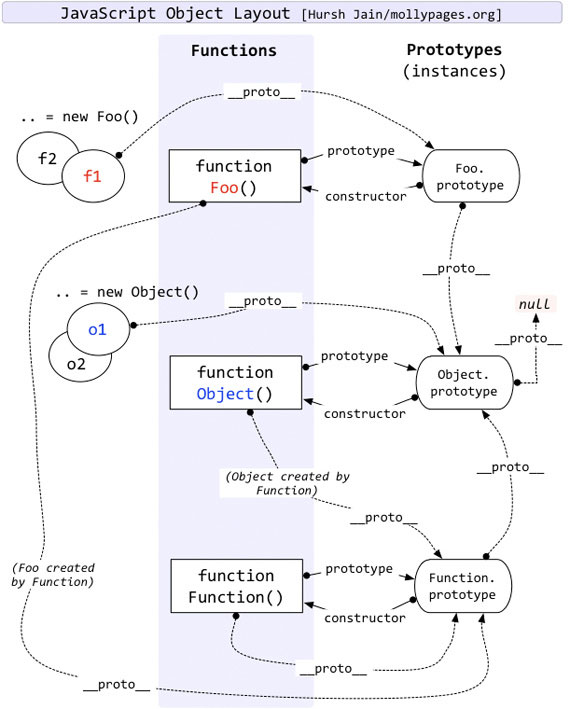您好,登錄后才能下訂單哦!
您好,登錄后才能下訂單哦!
本文實例講述了JavaScript使用原型和原型鏈實現對象繼承的方法。分享給大家供大家參考,具體如下:
實際上JavaScript并不是一門面向對象的語言,不過JavaScript基于原型鏈的繼承方式、函數式語法,使得編程相當靈活,所以可以利用原型鏈來實現面向對象的編程。
之前對JavaScript一直都是一知半解,這兩天看了一下原型鏈這一塊知識,綜合練習了一下JavaScript的對象繼承方式。
以下就是原型鏈和原型的關系,引用網上的一張圖

在Javascript中,每個函數都有一個原型屬性prototype指向自身的原型,而由這個函數創建的對象也有一個proto屬性指向這個原型,而函數的原型是一個對象,所以這個對象也會有一個proto指向自己的原型,這樣逐層深入直到Object對象的原型,這樣就形成了原型鏈。
- 基本繼承模式
function FatherClass() {
this.type = 'father';
}
FatherClass.prototype.getTyep = function() {
console.log(this.type);
}
FatherClass.prototype.obj = {age: 35};
function ChildClass() {
this.type = 'child';
}
ChildClass.prototype = FatherClass();
ChildClass.prototype.getType = function() {
console.log(this.type);
}
var father = new FatherClass();
var child = new ChildClass();
father.getTyep();
child.getType();
此方法有優點也有缺點,繼承的實現很簡單,代碼簡單容易理解,但是子類繼承父類的成員變量需要自己重新初始化,相當于父類有多少個成員變量,在子類中還需要重新定義及初始化
function FatherClass(type) {
this.type = type || 'father';
}
function ChildClass(type) {
this.type = type || 'child';
}
ChildClass.prototype = FatherClass();
ChildClass.prototype.getType = function() {
console.log(this.type);
}
var father = new FatherClass('fatClass');
var child = new ChildClass('chilClass');
上面這種情況還只是需要初始化name屬性,如果初始化工作不斷增加,這種方式是很不方便的。因此就有了下面一種改進的方式。
- 借用構造函數
var Parent = function(name){
this.name = name || 'parent' ;
} ;
Parent.prototype.getName = function(){
return this.name ;
} ;
Parent.prototype.obj = {a : 1} ;
var Child = function(name){
Parent.apply(this,arguments) ;
} ;
Child.prototype = Parent.prototype ;
var parent = new Parent('myParent') ;
var child = new Child('myChild') ;
console.log(parent.getName()) ; //myParent
console.log(child.getName()) ; //myChild
這樣我們就只需要在子類構造函數中執行一次父類的構造函數,同時又可以繼承父類原型中的屬性,這也比較符合原型的初衷,就是把需要復用的內容放在原型中,我們也只是繼承了原型中可復用的內容。
- 臨時構造函數模式(圣杯模式)
上面借用構造函數模式最后改進的版本還是存在問題,它把父類的原型直接賦值給子類的原型,這就會造成一個問題,就是如果對子類的原型做了修改,那么這個修改同時也會影響到父類的原型,進而影響父類對象,這個肯定不是大家所希望看到的。為了解決這個問題就有了臨時構造函數模式。
var Parent = function(name){
this.name = name || 'parent' ;
} ;
Parent.prototype.getName = function(){
return this.name ;
} ;
Parent.prototype.obj = {a : 1} ;
var Child = function(name){
Parent.apply(this,arguments) ;
} ;
var F = new Function(){} ;
F.prototype = Parent.prototype ;
Child.prototype = new F() ;
var parent = new Parent('myParent') ;
var child = new Child('myChild') ;
console.log(parent.getName()) ; //myParent
console.log(child.getName()) ; //myChild
個人綜合模式
《Javascript模式》中到圣杯模式就結束了,可是不管上面哪一種方法都有一個不容易被發現的問題。大家可以看到我在'Parent'的prototype屬性中加入了一個obj對象字面量屬性,但是一直都沒有用。我們在圣杯模式的基礎上來看看下面這種情況:
var Parent = function(name){
this.name = name || 'parent' ;
} ;
Parent.prototype.getName = function(){
return this.name ;
} ;
Parent.prototype.obj = {a : 1} ;
var Child = function(name){
Parent.apply(this,arguments) ;
} ;
var F = new Function(){} ;
F.prototype = Parent.prototype ;
Child.prototype = new F() ;
var parent = new Parent('myParent') ;
var child = new Child('myChild') ;
console.log(child.obj.a) ; //1
console.log(parent.obj.a) ; //1
child.obj.a = 2 ;
console.log(child.obj.a) ; //2
console.log(parent.obj.a) ; //2
在上面這種情況中,當我修改child對象obj.a的時候,同時父類的原型中的obj.a也會被修改,這就發生了和共享原型同樣的問題。出現這個情況是因為當訪問child.obj.a的時候,我們會沿著原型鏈一直找到父類的prototype中,然后找到了obj屬性,然后對obj.a進行修改。再看看下面這種情況:
var Parent = function(name){
this.name = name || 'parent' ;
} ;
Parent.prototype.getName = function(){
return this.name ;
} ;
Parent.prototype.obj = {a : 1} ;
var Child = function(name){
Parent.apply(this,arguments) ;
} ;
var F = new Function(){} ;
F.prototype = Parent.prototype ;
Child.prototype = new F() ;
var parent = new Parent('myParent') ;
var child = new Child('myChild') ;
console.log(child.obj.a) ; //1
console.log(parent.obj.a) ; //1
child.obj.a = 2 ;
console.log(child.obj.a) ; //2
console.log(parent.obj.a) ; //2
這里有一個關鍵的問題,當對象訪問原型中的屬性時,原型中的屬性對于對象來說是只讀的,也就是說child對象可以讀取obj對象,但是無法修改原型中obj對象引用,所以當child修改obj的時候并不會對原型中的obj產生影響,它只是在自身對象添加了一個obj屬性,覆蓋了父類原型中的obj屬性。而當child對象修改obj.a時,它先讀取了原型中obj的引用,這時候child.obj和Parent.prototype.obj是指向同一個對象的,所以child對obj.a的修改會影響到Parent.prototype.obj.a的值,進而影響父類的對象。AngularJS中關于$scope嵌套的繼承方式就是模范Javasript中的原型繼承來實現的。
根據上面的描述,只要子類對象中訪問到的原型跟父類原型是同一個對象,那么就會出現上面這種情況,所以我們可以對父類原型進行拷貝然后再賦值給子類原型,這樣當子類修改原型中的屬性時就只是修改父類原型的一個拷貝,并不會影響到父類原型。具體實現如下:
var deepClone = function(source,target){
source = source || {} ;
target = target || {};
var toStr = Object.prototype.toString ,
arrStr = '[object array]' ;
for(var i in source){
if(source.hasOwnProperty(i)){
var item = source[i] ;
if(typeof item === 'object'){
target[i] = (toStr.apply(item).toLowerCase() === arrStr) ? [] : {} ;
deepClone(item,target[i]) ;
}else{
target[i] = item;
}
}
}
return target ;
} ;
var Parent = function(name){
this.name = name || 'parent' ;
} ;
Parent.prototype.getName = function(){
return this.name ;
} ;
Parent.prototype.obj = {a : '1'} ;
var Child = function(name){
Parent.apply(this,arguments) ;
} ;
Child.prototype = deepClone(Parent.prototype) ;
var child = new Child('child') ;
var parent = new Parent('parent') ;
console.log(child.obj.a) ; //1
console.log(parent.obj.a) ; //1
child.obj.a = '2' ;
console.log(child.obj.a) ; //2
console.log(parent.obj.a) ; //1
綜合上面所有的考慮,Javascript繼承的具體實現如下,這里只考慮了Child和Parent都是函數的情況下:
var deepClone = function(source,target){
source = source || {} ;
target = target || {};
var toStr = Object.prototype.toString ,
arrStr = '[object array]' ;
for(var i in source){
if(source.hasOwnProperty(i)){
var item = source[i] ;
if(typeof item === 'object'){
target[i] = (toStr.apply(item).toLowerCase() === arrStr) ? [] : {} ;
deepClone(item,target[i]) ;
}else{
target[i] = item;
}
}
}
return target ;
} ;
var extend = function(Parent,Child){
Child = Child || function(){} ;
if(Parent === undefined)
return Child ;
//借用父類構造函數
Child = function(){
Parent.apply(this,argument) ;
} ;
//通過深拷貝繼承父類原型
Child.prototype = deepClone(Parent.prototype) ;
//重置constructor屬性
Child.prototype.constructor = Child ;
} ;
更多關于JavaScript相關內容感興趣的讀者可查看本站專題:《javascript面向對象入門教程》、《JavaScript錯誤與調試技巧總結》、《JavaScript數據結構與算法技巧總結》、《JavaScript遍歷算法與技巧總結》及《JavaScript數學運算用法總結》
希望本文所述對大家JavaScript程序設計有所幫助。
免責聲明:本站發布的內容(圖片、視頻和文字)以原創、轉載和分享為主,文章觀點不代表本網站立場,如果涉及侵權請聯系站長郵箱:is@yisu.com進行舉報,并提供相關證據,一經查實,將立刻刪除涉嫌侵權內容。